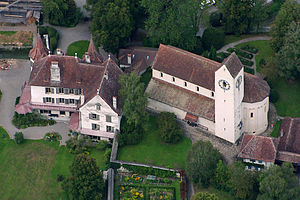
Amsoldingen is a municipality in the Thun administrative district in the canton of Bern in Switzerland.

Hilterfingen is a municipality in the administrative district of Thun in the canton of Bern in Switzerland.

Schadau Castle is a castle on the south side of the Aare near Lake Thun in the city of Thun, Canton Bern, Switzerland. It is a Swiss heritage site of national significance.

Reichenbach castle is located in Zollikofen, about 5 kilometres north of Bern. The castle was founded as a medieval fort, probably built on the site of an earlier Roman fort, on the river Aar. The medieval castle was later rebuilt in the Baroque style. It is a Swiss heritage site of national significance.

Wil Castle is a castle from the 13th and 16th century in the municipality of Schlosswil in the Canton of Bern, Switzerland. The castle is a popular destination for locals and is a Heritage Site of National Significance. It was the administrative seat of the Konolfingen District.

Sogn Parcazi Castle and Church is a ruined castle and fortified church in the municipality of Trin of the Canton of Graubünden in Switzerland. It is a Swiss heritage site of national significance.

Jörgenberg Castle is a castle in the municipality of Waltensburg/Vuorz of the Canton of Graubünden in Switzerland. It is a Swiss heritage site of national significance.
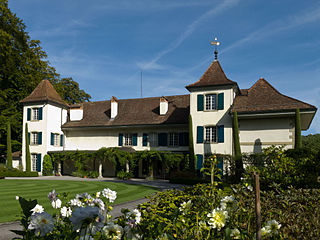
Bremgarten Castle is a castle in the municipality of Bremgarten of the canton of Bern in Switzerland. It is a Swiss heritage site of national significance.
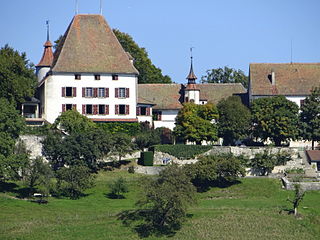
Burgistein Castle is a castle in the municipality of Burgistein in the canton of Bern in Switzerland. It is a Swiss heritage site of national significance.

Erlach Castle is a castle in the municipality of Erlach of the Canton of Bern in Switzerland. It is a Swiss heritage site of national significance.
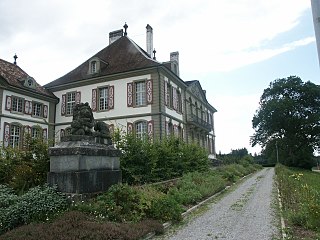
Hindelbank Castle is a castle in the municipality of Hindelbank of the Canton of Bern in Switzerland. It is a Swiss heritage site of national significance. It was sold to the canton in 1866 and later became a workhouse and a prison. Currently, it is the administration building of the only women's prison in Switzerland.

Jegenstorf Castle is a castle in the municipality of Jegenstorf of the Canton of Bern in Switzerland. It is a Swiss heritage site of national significance.

Köniz Castle is a castle in the municipality of Köniz of the Canton of Bern in Switzerland. It is a Swiss heritage site of national significance.

Münchenwiler Castle or Château de Villars-les-Moines is a castle and former Cluniac priory in the municipality of Münchenwiler of the Canton of Bern in Switzerland. It is a Swiss heritage site of national significance.

Gümligen Castle is a castle in the municipality of Muri bei Bern of the Canton of Bern in Switzerland. It is a Swiss heritage site of national significance.

Oberhofen Castle is a castle in the municipality of Oberhofen of the Canton of Bern in Switzerland. It is a Swiss heritage site of national significance.

Rümligen Castle is a castle in the municipality of Rümligen of the Canton of Bern in Switzerland. It is a Swiss heritage site of national significance.

Spiez Castle is a castle in the municipality of Spiez of the Swiss canton of Bern. It is a Swiss heritage site of national significance.
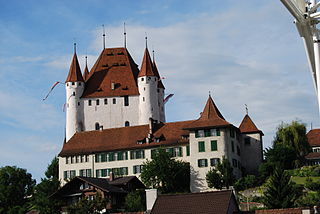
Thun Castle is a castle in the city of Thun, in the Swiss canton of Bern. It was built in the 12th century, today houses the Thun Castle museum, and is a Swiss heritage site of national significance.

Wimmis Castle is a castle in the municipality of Wimmis of the Canton of Bern in Switzerland. It is a Swiss heritage site of national significance.
